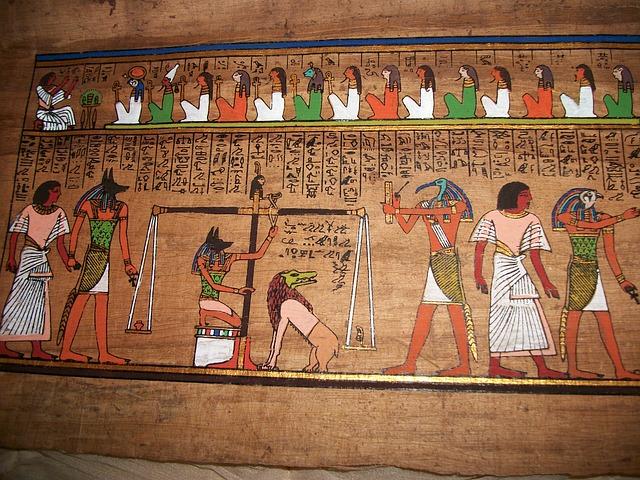Egyptian Beliefs
Egyptians believe in living a life balance and afterlife. They see the life in ancient Egypt as the best life anyone could live as long as they live by the laws of the Gods. The Gods provide them with everything they need. Egyptians value a peaceful and balanced life. A belief in the Gods made people feel contentment with what they have instead of focusing on other peoples’ wealth. A heart filled with gratitude would have a harmonious relationship with others; therefore, living a life of peace and balance.
They do not have scriptures of books to follow as a religion but instead live a daily life of reflection and self-repentance when they realized their wrongdoings. They have a god for everything, some are versions of the most revered one, and some were combined characteristics of the old god on in ancient Egypt. There is one thing about the gods of Egypt that sets them apart from other myths and religion, they tend to change from one duty to another, some are demoted, and some became more powerful. According to the pyramid text, a god who is a cannibal pharaoh should consume another god to increase their powers. Most of the Gods of ancient Egypt were replaced or forgotten, it might stem for the reason of simplifying the list of the Gods because let’s face it, the list is quite long and some have almost the same responsibilities and powers.
Since Egyptians believe in balance, every male God has its female counterpart. They may not have the same powers but some compliments one another. Tetrads of the four directions, winds and sons of Horus are a set of totality. The numbers like three and eight which represent the triads and another group of Gods called the Ogdoad gods.
Burials and Afterlife

Pharaohs and royalties are buried in a pyramid, but the ordinary people would have a regular funeral. It was customary for a tomb to have engravings of the person’s life on Earth for, without any of these, the soul would cease to exist. When a human dies, he would wake up without memories; thus, the importance of the engravings of his past life. This would remind him of how he lived and would now be ready to make his way towards the hall of truth to reach the gates of the field of reeds.
Lake of Flowers / Lily Lake
A body of water where the soul would need to pass, they would be ferried by the boatman called Hraf-Hef. He was said to be rude, and it is one of the hardships a soul must endure reaching the gate of the Hall of Two Truth.
Hall of Two Truth
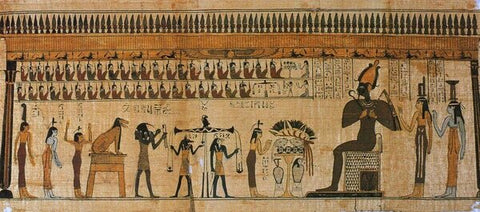
The hall of truth is the place where the souls of the deceased would be judged. The God who sits on the throne is Osiris, but Thoth and Anubis are part of the jury, as well as the other forty-two Gods as a panel of judges.
Based on the Book of the dead, there are ways to pass the hall of truth and reach the paradise called the field of reeds. The soul would first greet Osiris followed with the declaration of truth; these are the list of sins that should not have committed or should have repented when done. This is called the forty-two negative confession of sins. The judges will then deliberate if the admission is acceptable before the actual weighing of the heart against the feather of truth. If the heart weighs lighter than the feather of Ma’at, the soul would be granted a pass to the paradise called A’aru. Still, if the heart is heavier than the feather, the soul would be thrown on the ground and be fed to Ammut who patiently waits under the hall to devour the unworthy souls.
Book of The Dead

A book where a person must read and study to successfully pass the Hall of truth as well as to endure the journey to paradise. The book has a list of spells against the dangers that one might encounter. Demons roam around the underworld, and a pure soul would be its target. It’s like a reviewer with all the answers. The soul just needs to follow every spell and the correct conduct in front of the judges to be given a pass. The book is also a part of the tombs engravings. A reminder on how to act in front of Osiris and the forty-two judges.
Forty-two Judges According to the Forty-two Negative Confessions.
Usekh-nemmt – commit any sin
Hept-khet - robbery with violence.
Fenti - steal
Am-khaibit – kill men and women.
Neha-her - steal grain.
Ruruti - pocketed offerings.
Arfi-em-khet - steal the property of God.
Neba – tell lies.
Set-qesu - carry away food.
Utu-nesert - spoken curses.
Qerrti - adultery
Her-f-ha-f – make anyone cry
Basti - consume the heart
Ta-retiu - attack any man.
Unem-snef - deceit.
Unem-besek – steal cultivated land.
Neb-Maat - eavesdropper.
Tenemiu - slander
Sertiu – anger without just cause.
Tutu - corrupt the wife of any man.
Uamenti - corrupt the spouse of any man.
Maa-antuf - pollute myself.
Her-uru - terrorized none.
Khemiu – transgress the law.
Shet-kheru - angry.
Nekhenu - closed my ears to the verses of truth.
Kenemti - blasphemy.
An-hetep - violence.
Sera-kheru – stir up strife.
Neb-heru - act with undue haste.
Sekhriu - pry into matters.
Neb-abui - multiplied my words in conversation.
Nefer-Tem - did not wrong anyone, did no evil.
Tem-Sepu – work with sorcery against the king.
Ari-em-ab-f - stopped the water flow.
Ahi - raise my voice.
Uatch-rekhit – curse God.
Neheb-ka – act with arrogance.
Neheb-nefert – steal the bread of the gods.
Tcheser-tep - take the khenfu loaves from the Spirits of the departed.
An-af - take the bread of a child, nor treat the god of my city with disdain.
Hetch-abhu - kill the cattle that belongs to the god.
The Field of Rushes (A'Aru)
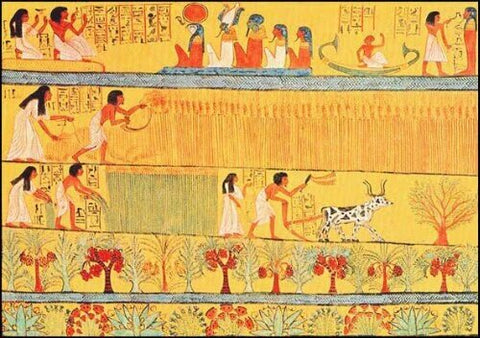
The field of reeds is the place where souls would live with the Gods. A paradise of some sort where they would assume whatever they had while they were mortals but in the absence of death and live together with their loved ones. This is why sculptures of their previous life on Earth were an essential part of the tomb for the life they lived depicted on the grave would be carried over to the afterlife.
The soul would be judged on how honorable he was in his past life and face judgment in the hall of truth. He will then be granted a pass towards paradise also known as the Field of the rushes or A’Aru.
Four winds of the Afterlife
The four winds of the afterlife were said to bring the breath of life back to the deceased.
Four texts on the coffin
According to the book of the dead, the coffin must have these four engravings on each corner. Four corners of a coffin would have the text of Ra lives, the tortoise is dead, the dead body is buried, and the corpse’s bones are reunited. These four text means that the Ra defeated the tortoise and Osiris has reclaimed his physical honor.
The Story of the Beginning
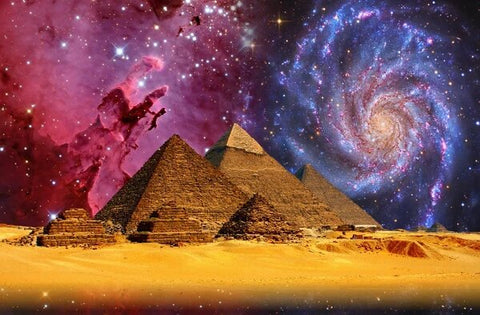
There are five original God that created the world. Osiris, Isis, Set, Nephthys and Horus. Ra, the sun God created the world with Heka and Thoth. Ra has tasked Osiris and Isis to govern over Egypt.
Set became envious of his brother Osiris and killed him. The body was thrown into the Nile River. His wife, Isis found his body and tried to bring him from the dead. As she was gathering the herbs to resurrect her husband, Set came back and chopped Osiris body to pieces and cast it across the land. There are two versions of how Osiris was resurrected. First is that Isis came to find almost every body part except for his phallus for it had been eaten by the fishes. As Osiris was not resurrected in his full body, he then came down to the underworld to sit in the throne and judge the heart of the souls for the dead. He then became the god of the dead that rules over the Hall of Truth. Isis then was already pregnant with their son Horus the young. The second version is that every part was eaten by the animals except for the phallus. Isis used the phallus to conceive their son Horus.
Horus grew and sought revenge on his uncle and then came to lead Egypt in place of his father. There are two versions of how Horus came to be the ruler of Egypt. One is that he won over Set at as one of his eyes was gouged out by his uncle while he was able to cut off his testicles. Another version was that the two of them were evenly matched that after eight days of fighting, the goddess Isis other gods interfered and pronounced Horus as the ruler and castoff set.
Heliopolis Version of the Creation of the Universe:

The light was created on the first day of creation. The sun God Ra rose from a blue gigantic lotus flower from revolving bubbling water which is the god named Nu. Ra then gave light to the cosmos. On the second day, Shu and Tefnut were created by Ra that brought about the creation of moist and air. Shu and Tefnut then gave birth to the sky, and the ground is known as Nut and Geb on the third day of creation. Geb and Nut were separated by their mother Ra for they married against their fathers wish. The calendar was created with the help of the God of learning and wisdom Thoth for Nut to give birth to Osiris, Horus, Seth, Isis and Nephthys. From the fifth to the seventh day of creation, Khnum created life with the use of his potter wheel. He created all that inhabits Earth. Meticulously creating every single part, from the skin and all the internal organs that the life would need to survive. He would then lift his creation for Ra to give life to them.
The nine Gods of the Osiris mythology / The Great Ennead
Atum
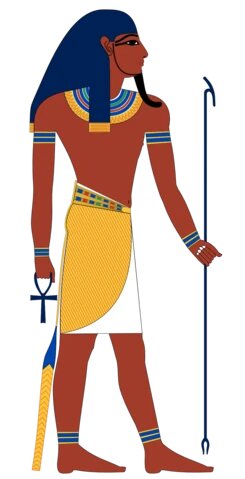
Known as “the complete one”. He is the creator of all. He was said to rise by himself from Nu, the prehistoric waters where the Gods were created. He was lonely and spat out Shu in Tefnut to have companions. Shu and Tefnut went on their own and Atum had the Eye of Ra bring them back. Seeing them again, Atum was so happy that he cried tears of happiness and these tears were made into humans. The humans have nowhere to live, so Tefnut and Shu mated to gave birth to Nut and Geb. He is illustrated as a man with the royal crown with a Hedjet and a Deshet. He sometimes takes the form of a serpent, lion or a bull.
A Hedjet is a white crown that represents the upper part of Egypt, and a Deshet is a red crown that represents the lower part of Egypt. Together, they form a crown known as a pschent.
Shu

An ancient god of the air. He was the father of Nut and Geb which represented the sky and Earth for people to live. Shu is illustrated as a man holding the sky and represents the dry air at the center of Earth and Sky His name translates to “Emptiness”. His mist was called the “lake of Shu”, and the clouds are known as the “bones of Shu”. He also protects the sun barge of Ra and is sometimes portrayed as a man with a lion head holing an Ankh.
Tefnut

Illustrated with a lion head with a sun disk and a serpent facing the front and the back. She has control of rain and water being the goddess of moisture. Mother of Geb and Nut and wife to Shu. She reigned over the Earth’s atmosphere and was worshipped in a Lion form. The house of Tefnut can be found in Denderah city. Her name translates to “The water” which according to some text, she produces pure water.
Geb / Seb
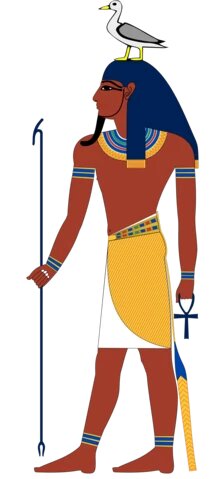
Son of Shu and Tefnut. A representation of Earth as we know it. He is illustrated as a man with a goose on his head holding a sceptre and an ankh. He was known to be the father of snakes. It was once believed that the fruitfulness of Osiris, and the chaos of Seth, came from his father. His laughter would create earthquakes that would fertilize the soil as well as bring destruction.
Nut
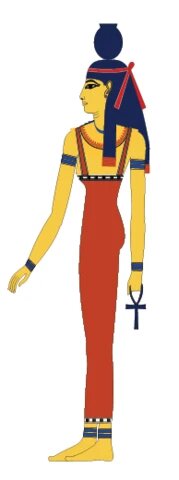
The goddess of the sky. She embodies the heavens, daughter of Shu and Tefnut who created Nut and Geb as a place for people to live. She and her brother Geb had a relationship that angered Atum that decided to set them apart. Nut being pregnant with Geb’s children, she was forbidden to give birth on all the days of the calendar. Thoth intervened and made a way to help Nut. She then gave birth to her children, namely Isis, Osiris, Nephthys, Horus and Seth. During ancient Egypt, the souls of the dead were believed to rise to the heavens and become stars. She was illustrated as a woman with a water-pot on her head while holding an ankh. She often takes the form of a cow.
Osiris / Usir
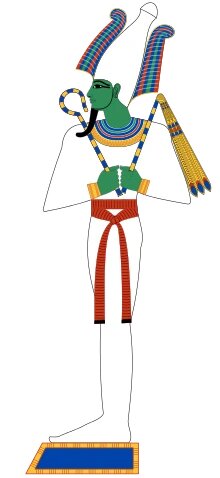
The son of Geb and Nut. His Egyptian name means powerful. Usir was initially been the god of fertility. He was famous and He sits on the throne of the Hall of Justice. His name translates to “mighty”, he was popularized with the myth called Osiris myth which is about his existence and how he came to overcome death, be the God of death, and be the judge in the hall of truth. He was depicted as a mummified man with green or black skin; the color is a representation of the Nile River, and his original form as a fertility god. His death and resurrection is an example of how a soul can live in the afterlife and journey to the place called the field of reeds or A’aru. He is seen wearing a headdress of an Atef holding a scepter and a flail.
An Atef crown is a with a Hedjet and curly ostrich feather on both sides.
Osiris – Apis
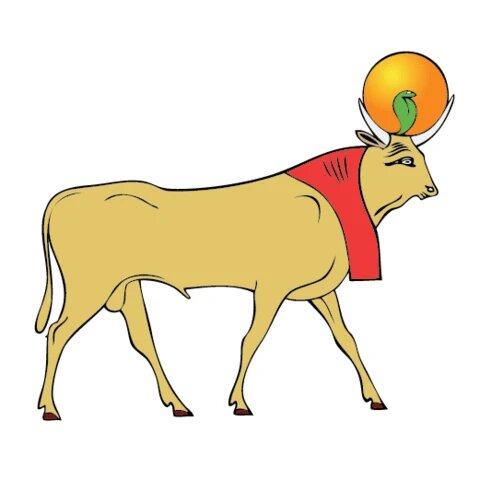
A version of Osiris in a bull form. A bull is a symbol of fertility and virility. Osiris being the god of fertility is best represented by this animal that formerly symbolized the god Ptah.
Isis
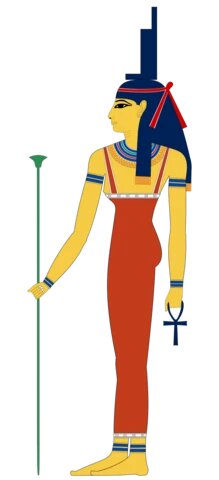
“Mother of the gods” and “the great magic”. A nurturing goddess who cares for the living and assist the souls of the dead to reach the field of Reeds safely. A symbol of a mother to all kings. She is portrayed as a woman with yellow skin and a tall chain on her head. She also holds a staff and an ankh.
Zenenet – a version of the goddess Isis in the city of Armant.
Isis – Eutheria – a facet of Isis that mourns over the death of Osiris that contributes to the flooding of the Nile River.
Nephthys

One of the offsprings of Geb and Nut and a mother to Anubis. Her name translates to “Mistress of the House” that represents the temple in heaven. She was illustrated as a woman with a house on her head. Also famous for being a goddess of mourning and burials with the act known as the “kites of Nephthys”, She was also known to be a friend of the dead and was one of the major players of Osiris myth wherein she was Isis resurrected Osiris after dying from the hands of Set.
Set
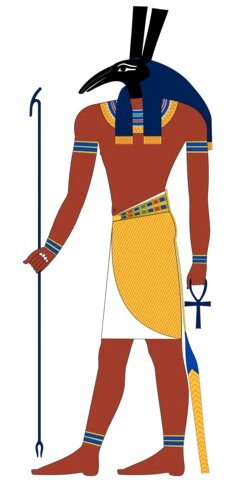
The god of war, chaos, and deception. He was once god that protects the sun barge of Ra (Atet) as it travels the netherworld. He is illustrated by the Set animal, a creature like no other. He is depicted as jackal head, giraffe horns, round snout, and a forked tail. It was said the Set came to kill his brother in the guise of his animal form.
Ogdoad of Hermopolis (Khmunu)
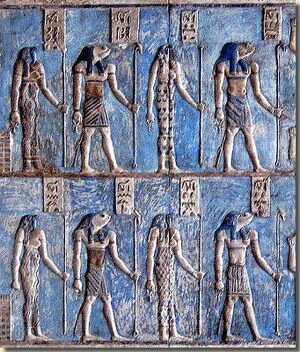
The eight gods that represent the prehistoric elements of the creation of the universe.
Kek and Kauket

The Gods of blackness and night. The male and female aspect of darkness without its negative aspect. Kek was known to be the “bringer of light”, he would usher the sin barge of Ra from the underworld to the sky before dorn. He rules over the hours before sunrise. Kauket, the female counterpart of Kek is known to be “the bringer of darkness”. She ushers the sun barge to the underworld as it the sun sets at dorn. She rules over the hours before sunset.
Amun and Amunet
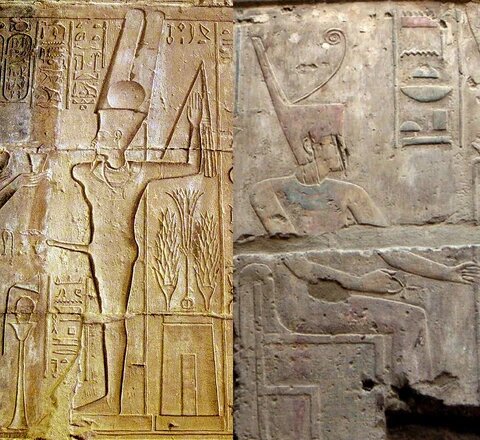
Amunet, the goddess of air and is the female counterpart of Amun. Her name is interpreted as “a female who is hidden. She was the daughter of Horus and Hathor. She is illustrated as a woman with wings and ostrich feathers. Amun is illustrated as a man with two plumes on the top of his head holding a staff and an ankh. He was said to create all the gods from himself.
Nu and Naunet
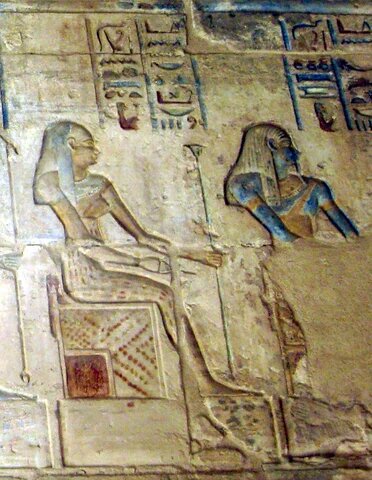
Nu, known as the father of the gods, the prehistoric water where gods rose from to bring order to the universe. Naunet is the female counterpart of Nu.
Heh and Hauhet

Deities portrayed as a frog and a serpent consecutively. The Gods and Goddesses of infinity and eternity with their names that translates to the word “endlessness”.
Triad of Latopolis
Khnum
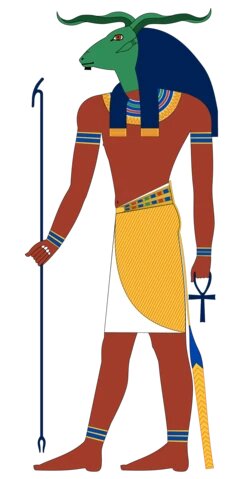
Known as “the great potter” and as the patron so pottery. He portrayed with a ram head and carried a staff and an ankh. He is also illustrated with crafted children that stands on his pottery wheel. He is the said creator in the Egyptian version of the creation of the universe known as the Heliopolis version. He worked for three consecutive days in meticulously forming and completing every part of all his creations.
Neith
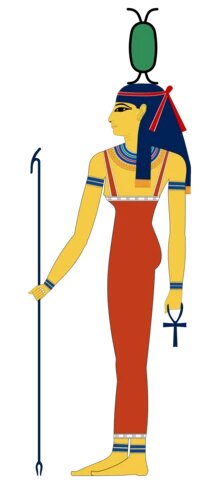
Considered one of the oldest gods that date back to prehistoric Egypt. A combination of a war goddess with the name Mistress of the Bow. A creation goddess is known as the mother of the Gods. She acts as a moderator of Gods during disagreements. She was also known as a funerary goddess and as one of the judges in the hall of truth. She is illustrated as a woman with crossed arrows and shield on her head with a scepter and an ankh on her hands.
Heka
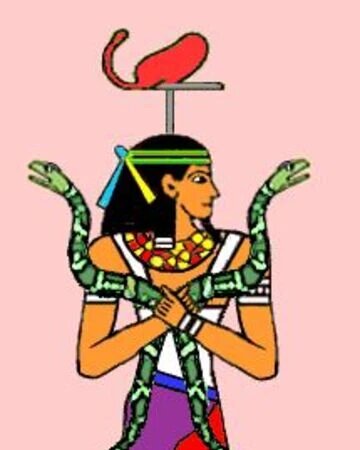
A god of ancient Egypt also known as the patron god of medicine and enchantment. The son of Menhet and Khnum. Magic and medicine go hand in hand I Egypt’s medical practice. He is illustrated carrying a knife and a scepter made of two serpents that according to the myth, he had slain, interlaced and made into a scepter to represent his power. A person who practices medicine is called the priest of Heka. He was originally believed to be the source of power during the creation. He is linked to Hu and Sia, the representation of the tongue and heart of Ptah.
Theban Triad
Amun-Ra
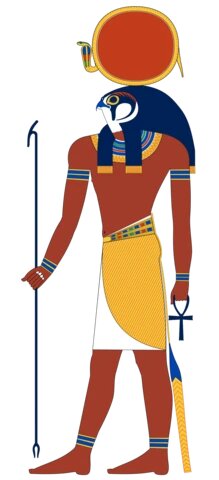
Amun is translated as “the invisible”. Branded as the lord of the silent, he is the patron God of Thebes and is drawn a man with two plumes in his head holding a scepter and an ankh. When the god of the wind Amun combines with the sun God Ra. Amun-Ra became the all-powerful God of air and sun. He was thought to be the most powerful god in the New Kingdom of Egypt. He looks similar to Amun with the additional sun disk in his head. A royal woman given the position of the wife of Amun would have the same power as that of a pharaoh.
Auf
Considered a facet of Ra.
Mut
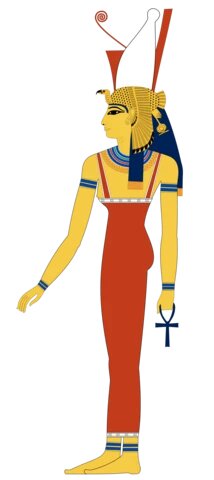
Wife of Amun and mother to Khonsu. An ancient mother goddess that protects the souls that was confined by the demons in the afterlife. She also acts as a heavenly custodian of the kings who roast his foes in her fiery brazier. She is illustrated as a woman with a Hedjet and a Deshet on a vulture headdress while holding an ankh. She was branded as “Lady of heaven”.
Anta
A version of Mut, worshipped in Tanis as the wife of Amun.
Khonsu
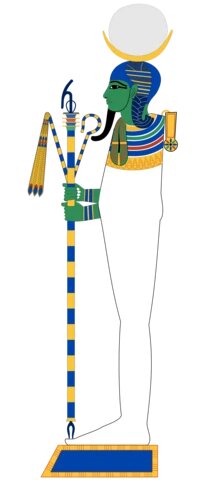
“The traveler” and was the god of the moon. He was illustrated as a mummified body with uraeus and a moon disc on his head while holding a staff and a flail. He replaced a former god named Montu and became famous for his miracles and healing powers. He is portrayed as a green-skinned man with a moon disk on his head while holding a staff with a flail and a scepter.
Triad of Heliopolis
Hesat / Hesahet
Considered to be a part of prehistoric Egypt and known as the goddess of food and drink. She was depicted as a white cow with a platter of food on his head and flowing milk from her mammary glands. Her milk was called “the beer of Hesat”. According to the pyramid text, she was the mother of Anubis and a facet of Hathor who is also represented by a cow.
Mnevis
An ancient god, which is represented by a black bull with a sun disk and uraeus on his head. Considered as a facet of Atum-Ra and a son of Hesat. Unlike the Apis bull, Mnevis bull should have a thorough black coat. He was replaced by the Apis bull later in the myth.
Anubis

The god of mummification and mummifying. Illustrated with a hound or a jackal head, that carries an ankh scepter. Father to Qebhet. He is the son of Bastet and Hesat though some say he was the son of Osiris from Nephthys. It was believed that the body of the deceased must have a sweet smell to before Anubis guides it toward the afterlife.
Triad of Elephantine
Khnum
Companion to Satis, a father to Anuket. He is represented by a potter’s wheel and is the patron of potters. Originally adulated as the god of the Nile and a creator of all creations, even the gods. He is known to be “the Divine potter”. He is depicted with a ram head and carried a staff and an ankh.
Satis
The Guardian of the southern boundary of Egypt. Her name translates to “pourer” and was known to be an ancient goddess that represents the flooding of the Nile River. She was also worshipped as a war and fertility goddess. As the name and characteristics, if Egyptian god evolves with time, she was replaced by the eye of Ra or Hathor the same way Ra replaced Khnum. She is pictured as a woman wearing a hedjet with antelope antlers as she carries a bow and arrows or an ankh and a staff. She was also drawn pouring water over the pharaoh during purification rituals just like her name signifies.
Anuket
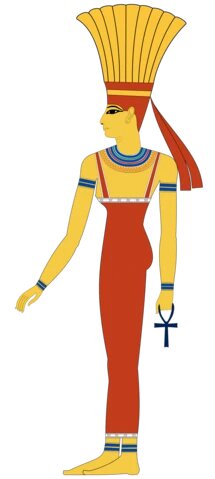
One of the original gods of Egypt and known as the Goddess of the Nile and lust. Daughter of Khnum and Satis. Her name translates to “Embracer”. She is illustrated by a woman with a headdress adorned with ostrich feathers. She also holds a staff and an ankh.
Old Gods of Ancient Egypt
Ptah

One of the ancient god of Egypt that predates Osiris. A god worshipped in Memphis that was believed to create the world. God of truth and custodian of Memphis. A patron god to sculptors for it was supposed to be the way he created the world. Portrayed as a mummy wearing a skull headdress while carrying an ankh and the Was scepter. He was also known as Ptah-nu or Ptah- Naunet linking him to the ogdoad gods Nu and Naunet.
Ptah - Sokar - Osiris
A combination of three gods that represent birth death and resurrection adulated in the middle kingdom.
Aten
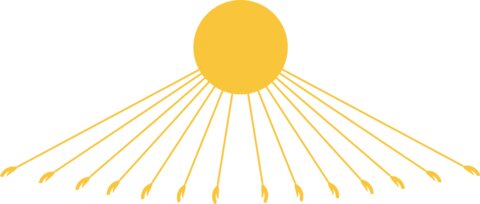
The original creator of the universe, considered as the sole god by Akhenaten. His name is interpreted as “disk” and is represented as a sun disk with sunrays below. It was believed back then that night is a dangerous time for Aten is not present. The belief in Aten was later abolished by Horemheb.
Jupiter – Amun
Adored at the Siwa oasis in Egypt, a Roman version of the ruler of the gods, Amun.
Ra
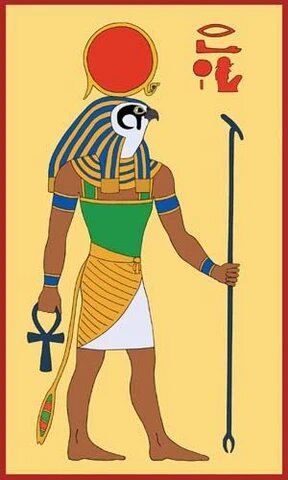
The sun god who brings the sun across the sky with his sun barge. He travels the heavens and the underworld with the help of other gods who protects him from the attacks of the cosmic serpent Apep. He is represented by a man with a hawk head carrying an ankh and a scepter. He wears a head headgear with a serpent and a sun disk that represents protection and rebirth. He is popular with the symbol of the Eye of Ra, which is his female counterpart. The sun is a perfect symbol of life, death, and resurrection. A newborn child at dawn and a dying entity at dawn, to be reborn again at sunrise.
Eye of Ra
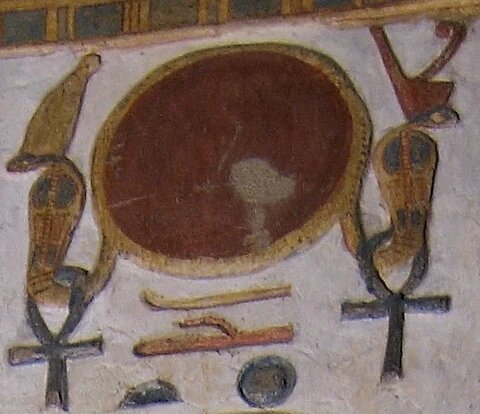
A female counterpart of Ra and was said to destroy his foes. Represented by a sun disk and was told to be an extension of Ra’s power. There are many stories behind the forces and symbolism of the eye. It was said be Nut, the sky goddess. Then became the eye of Ra and later became Hathor. The eye of Ra represents the sun that journeys across the sky held by the sun barge of Ra.
Ra – Harakhte
A combined god of Horus and Ra. The name translates to “Horus of the horizon” and is represented by a man with a hawk’s head adorned with a crown decorated with a sun disk that represents Ra.
Raettawy / Raet – Tawy
A feminine facet of Ra that is closely represented with Hathor. Also identified as “The lady of the sky and Earth” or “Raet of two lands”. She was also believed to be the wife of Montu. She was later replaced by Isis later in the myth. She is drawn as a woman with horn of cows and a sun disk in the middle.
Hathor
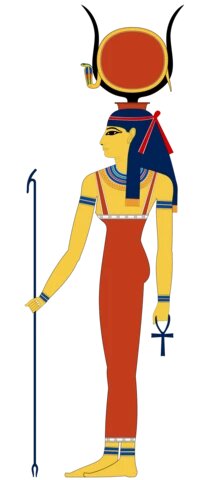
Daughter to Ra and a wife to Horus. “The lady of the sycamore”. One of the ancient goddess who was tasked by Ra to terminate humanity for all its sins. As the other gods implored to Ra to stop the destruction, Ra then had a drink with Hathor concealing a vat of beer under a red hue that resembles the color of the blood. When Hathor woke up from her drunken sleep, she became s compassionate and friendly goddess to all. She also rode the sun boat and defended it from the serpent’s attacks. The goddess of love, women, joy and drunkenness. She was also a cow deity like her predecessor Bat. Her characteristics were later absorbed by Isis. She is illustrated as a woman with hornsof a cow holding a sun disk at its center and a serpent facing forward.
Hathor – Nebet – Hetepet
A version of Hathor venerated in Heliopolis. She represents the hand of the absolute god Atum-Ra.
Horus the elder
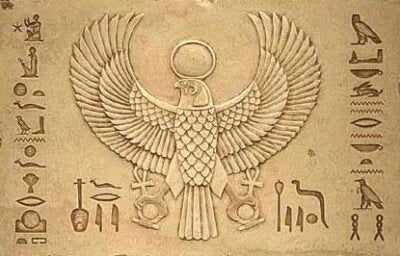
One of the offsprings of Geb and Nut. He was the embodiment of life in contrast with Osiris, who represents death or the ruler of the underworld. He was regarded as a pharaoh, and the alleged status was passed on to Horus the younger.
Horus the Younger
The son of Osiris and Isis. Depicted by a falcon or with a falcons head. He ruled over the sky and was said to have the sun as his right eye on the moon on his left. After the battle between Horus and Set, he lost one of his eye that brought upon the “Eye of Horus”.
The pharaohs of the land were believed to be a rebirth of Horus and are purified by the gods. A vessel of the gods to lead the humans.
The Eye of Horus
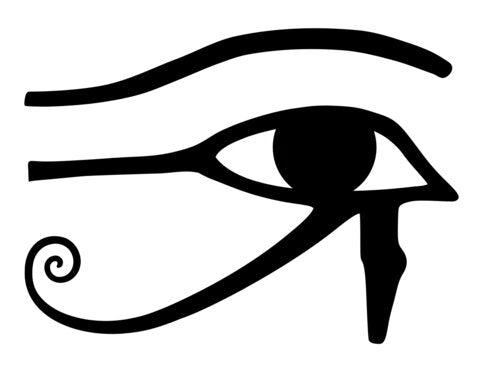
The eye of Horus was said to come from the Eye of Ra. A symbol of protection that is popular among Egyptians. Popular as an amulet or a pendant that was said to protect the pharaoh in the spirit world and repel evil forces. The symbol was also used on boats for safe journeys. There is an actual arithmetic value known as the Horus eye fraction but was later proven as a myth.
Haroesis
The sky facet of Horus the great. He takes the form of a falcon on Earth.
Harpocrates
A young boy with wings with his finger on his lips that denotes as a keeper of secrets and confidentiality. Also known as Horus the child.
Panebtawy
A Greek version of the young Horus. A young boy with a finger on his lips having a name that translates to “Lord of the two lands”. The son of Kom Ombo and Tasenetnofret which are also versions of Horus’s parents.
Iusaaset
Known as the “Grandmother of the gods”. She existed during the creation of the world and is linked with the tree of life “The lady of Acacia”, the Acacia tree is one of the oldest trees in Egypt which in turn describes her originating in during the creation of the universe. She was illustrated as a woman with vulture headdress decorated with a sun disk at the center of the horns while carrying an ankh and a scepter.
Iw
Worshipped at Heliopolis with the combined characteristics of the Gods Hathor, Nebet and Hetepet. Considered as a creation goddess.
Ma’at
The goddess of Justice and peace. Her title translates to “that which is straight”. She wears an Atef crown with ostrich feathers representing purity and justice. She is represented with a white feather known as the feather of truth. The heart of the deceased would be weighed against the feather of Ma’at to judge the purity of one’s soul. She is the embodiment of harmony and cosmic balance, a belief that there is an appropriate time for every action.
Maahes / Mihos / Mysis
A powerful lunar god illustrated with a man with a lion head holding a long knife. He is also known as the “True before Ma’at” and “Lord of slaughter”, the later describes how he punishes those who do not follow that blessed order of life.
Hapi
The god of the Nile. He is accountable for the yearly flood if the Nile River. He has blue skin with a pot-belly.
Aah/Yah
Moon God to whom Thoth was said to have gambled with for Nut to give birth to her children. Atum has ordered for Nut not to be able to give birth on any day of the year. Thoth helped Nut for she was pregnant by the time she and Geb were separated. Thoth, having won over Yah, have divided the moonlight into days where nut can give birth. He is illustrated similar to Khonsu with a full wig instead of the side braid of Khonsu.
Aken / Aqen
Warden of the boat that transports the soul of the deceased. He is also known to be a protector of the sun boat of Ra and is labeled as “mouth of time” with a name that is interpreted as “the protector”.
Asclepius / Aesculapius
Originally a Greek god but is also venerated by the Egyptians of Saqqara. Believed to be the God of healing with a scepter similar to Heka’s with a serpent hugging the body of the scepter. The current symbol used in the medical field, known as the Rod of Asclepius.
Ash / As
The God of the desert of Libya that provides a sanctuary for voyagers.
Fetket
The patron God of bartenders and works as a butler for Ra.
Hu
A representation of the tongue and first word uttered by Ra. Hu is known to be “the god of the unspoken word” which brought life to all creations.
Ihy
The god of music and happiness. The son of Hathor and Horus the Elder. He was worshipped at Dendera with his mother, Hathor. He is called upon during celebrations and honored by inscriptions of his birth on the walls of birthing houses for they consider music and laughter should welcome the newborns as they come into the Earth.
Mandulis / Marul
A lunar god adulated in Upper Egypt and along the Nubian border. He was illustrated as a man with falcon head garbed with a horned headdress. He represents a form of the sun during sunrise and sunset. Sunrise symbolizes the birth of a child and the sunset is a symbol of an adult entering the afterlife and be reborn the next day at dawn.
Mau
Another representation of Ra presents the start of the creation of life. A feline goddess that protects the tree of life from Apep, the serpent who wants to steal the secrets to eternal life.
Mehet – Weret
One of the oldest sky goddess represented by a cow that rose from prehistoric waters that gave birth to the sun god Ra. She was a symbol of fertility and prosperity. A precursor of Hathor wherein after she gave birth to Ra, she placed him in between her horns and lifted him to the sky just like how Hathor is depicted in the latter part of the myth.
Mehit / Meyht
One of the oldest moon goddess. She was illustrated as a stretch out lioness with a stick protruding behind her. She sets off and brings backs transformation to Ra.
Merit
Originally the goddess of music that played the symphony as the universe was created. She was later replaced by Hathor and became a forgotten deity.
Meskhenet
One of the ancient goddess of childbirth. She is responsible for creating one’s soul and its destiny as she also mould its characters. She is present during delivery as well as in the hall of truth to comfort the souls. Represented by a birthing stone which women in labor squat on as they give birth to a new being. She was also replaced by Hathor but is still worshipped up to this time.
Nebethetpet
The personification of the hand of Atum venerated at Heliopolis.
Nefertum
An aspect of Atum with his name that translates to “Beautiful Atum”. The god of perfume and sweet scent. He was later called upon for aromatherapy used in incense.
Nehebkau / Nehebu-Kau
A guardian deity whose duty is to unite the body with the soul. He was said to exist even before the creation of Atum and takes the form of a serpent. His name is interpreted as “He who unites the soul”.
Nehmetawy
A name that is interpreted as “she who holds those in need”. Wife to Nehebkau and is considered a protector goddess.
Qudshu / Qadesh
Goddess of love and sexual pleasure. Partner to the God of war, Reshep was revered in the new kingdom. A name that translates to “Holy” and was illustrated as a woman holding a lotus flower that denotes fertility and serpents on her left hand that indicates the slithering temptation of ecstasy.
Renpet
A personification of the year with a symbol of a palm branch. A palm branch represents the passing of the year. A minor deity with no followers but is essential to the Egyptian culture and beliefs.
Sah
A representation of a constellation called Orion. He is also renowned as the “forefather of the Gods”. He is represented by a man with an ankh and staff while standing on a boat under the constellation of Orion. His duty is to welcome the souls of the deceased in the afterlife.
Serket
A goddess represented by a woman with a scorpion on her head. A protective deity depicted by the protective pose of the scorpion on her head. She protects people from venomous bites. The story tells that she used her scorpions to guard Isis, there was a mother of a young boy who was unpleasant to Isis. As punishment, she had a scorpion sting the boy. Isis, a nurturing mother, saved the boy and forgave the woman. From then, Serket transformed into a protective nature and followed the examples of Isis.
Seshat
Her name is interpreted as “the female scribe”, the goddess of writing. Patron god of public and private libraries. She makes sure that the scribes and the measurements of the buildings are correct. Patron to builders and architects.
Shay
God of fate, he rules over one’s purpose He was described to be inescapable, and his decisions over one’s destiny cannot be altered. He was originally known as Agathadaimon, who is a snake god that has prophetic powers.
Sia
The god that represents the heart and intellect of Ptah. He is illustrated as a man that stands to the right of Ptah with a scroll on his hand. He is also one of the gods that protect the sun barge of Ra.
Sokar
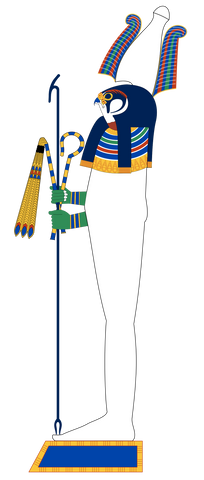
One of the oldest deity that is depicted as a man with a falcon head or takes a form of a falcon. A funerary god that guard the entrance of the gates of the afterlife. He is also responsible for transporting the soul of the deceased king to the field of reeds.
Star gods
A group of gods and goddesses represented with the night sky also known as the “stars that know no rest”. There were five planets that were discovered, and they named as the following:
Sebegu
Astral form of Set, also known as the planet Mercury.
God of the Morning
The planet Venus.
Horus of the Horizon
The planet Mars
Horus who limits the two lands
The planet Jupiter
Horus bull of the heavens
The planet Saturn
The stars also represent the astral form of the god Osiris, Isis and Horus, they were known as the followers of Osiris. Osiris in the form of Sopdu, Isis as Sothis and Horus as Horus-Sopdu.
Sothis
An ancient goddess that is either version of Isis or was replaced by Isis. She represented Sirius the star and was venerated as a cow goddess. She was originally depicted as a cow with a plant in between her horns and later took the form of a woman wearing a crown of Upper Egypt with a star.
Ta- bitjet
The goddess against venomous bites and stings. She is venerated and called upon through rituals of healing and was later replaced by Isis.
Tasetnofret
A local version of Hathor venerated at Kom Ombo. Her name translates to “the good sister”. Companion to Horus and a mother to Panebtawy.
Tetenen
An ancient God from the old kingdom that represents the creation of Egypt. Adored in Memphis and was also known as Kehnty-tjenenet, a version of Ptah, Ra and Atum. He is considered a God of both sexes and thus also called "the mother of all gods".
Tayet
Considered as an old goddess of weaving from the ancient kingdom. A custodian of the king’s body. Her duties are to protect the king after passing and to collect his bones and make sure that the soul of the king would be greeted on the spirit world. An embalming Goddess later in the myth that is tasked to weave the cloth used during the embalming of the deceased king.
Wepset
A goddess whose name translates to “she who burns”. Her duty is to destroy Osiris’s foes. She takes the animal form of a snake or a woman with a combination of the uraeus, sun-disk, and antlers.
Four Sons of Horus
Duamutef
Son of Horus and the custodian of the jar that contains the stomach. He is in charge of the Eastern part of Egypt and was governed by the Neith.
Hapy
Son of Horus and the custodian of the jar that contains the lungs. He is in charge of the Northern part of Egypt and is under the watch of Nephthys,
Imset
Son of Horus and the custodian of the jar that contains the liver. He rules over the southern region of Egypt and was supervised by the goddess Isis.
Qebehsenuef
Son of Horus and the custodian of the jar that contains the intestines. He rules over the western region of Egypt. He was overseen the god Serket.
Gods of War
Anat
The most beautiful goddess, the Egyptian version of Aphrodite. The goddess of love, combat, and sexuality. She is illustrated as a woman wearing an Atef and carries an ax. A combination of a fierce warrior and a nurturing woman.
Anhur (Onuris)
The god of war. The patron of the Egyptian soldiers. He was illustrated as a man with four plumes on his head with a lance and an ankh. He was labeled as “the slayer of enemies.
Mekhit
One of the distant goddess wherein the myth tells a time where the Eye of Ra went to Nubia and transformed herself into a lioness. She was captured by Onuris and escorted her back to Ra where she gave birth to Mekhit. She was given as a companion of Onuris. She was labeled as “she who massacres”
Reshep
A war god during the New kingdom. A god of chaos like Set who was illustrated as a bearded warrior with a war club wearing a Kaunakes. He was said to be a god of pestilence who assaults his prey with his arrows.
Gods of Fertility
Andjety
God of Fertility and worshipped during prehistoric Egypt in the city if Busiris. A prehistoric god that was replaced by Osiris in ancient Egyptian myth. He was said to predate and the precursor of Osiris due to the same Atef crown they wear and the scepter and flail they hold. He is called as the “bull of vultures” represented in by the Egyptian hieroglyphs that looks like a uterus.
Bastet / Bast
Daughter of Ra and the goddess fertility and childbearing and a guardian against evil and bad luck. She is illustrated with a cat head and was celebrated in Bubastis. She is commonly known as the Cat goddess and Protector of kings.
Bat
Depicted with a cow head and is considered the goddess of fertility and victory. She has the foresight and can also see the past, the reason why she was related to the king’s victory. Hathor absorbed Bat later in the myth.
Bes / Aha / Bisu
Protector of mothers and babies from scorpion bites and nightmares. A dwarf god with some lion facial features. He was illustrated as lion standing on its hind legs like a human. He is sometimes drawn with plumes in his head and carrying a sword. He is the God of birthing and fertility. A spirit worshipped as a God by the Egyptians represented in their home furniture’s and mirrors to protect them firm evil.
Taweret
Companion to Bes, a god represented by a hippo that is also a God of Fertility and childbearing. A dwarf with beard, big ears, and holding a rattle. Custodian to children and is often place facing the children.
Hapi
God of fertility and the Nile sludge. He was said to cause the overflow of the river banks in order to pour the rich soil deposits over the farms for the farmers. The god of fertility that is described to have ample bosoms and belly.
Heqet
Depicting a woman with the head of a frog, she is the Goddess of fertility and childbearing.
Hershaf / Hershef
A god of fertility depicting the head of a ram. He wears a version of an Atef with the sun disk and the crown of Osiris. He is garbed with a kilt and carries an Ankh as a key and a scepter. His name is interpreted as “He who is over power” or “He who is on his lake”. He was said to arise from primitive waters of Nu; he was worshipped in Henensuten. First considered as a facet of Khnum but later described as the soul of Osiris d Ra.
Iabet
The “She of the East”, the goddess of fertility and reincarnation. The cleanser of Ra who cleans the sun before sunrise. She rules over the Eastern region of the desert.
Khentiamenitu
A former fertility god that later became a god of funerals. His name when translated means “First of the Westerners”, this name features his power over the west. He was replaced by Osiris when he became the God of the dead.
Min
A god of the eastern par region of the desert and acted as a guardian to travelers and as an ancient fertility god represented by the black fertile soil of the Egyptian delta. He was portrayed as a man holding his phallus in one hand and a flail on the other side. He is a husband of Isis and the father of Horus.
Egyptian Gods of Virility
Babi / Baba
The god of virility. A baboon that depicts the sensuality of the male gender.
Banebdjedet
A god of virility and Fruitfulness. Drawn as a man with a ram head with four souls of the sun god on top of his antlers. He was believed to be a facet of Osiris worshipped in Mendes City. Husband of Hatmehit and father to Horus the Child. Together they form the Triad of Mendes.
Egyptian Gods from Nubia
Apedemak
A war God portrayed as a coiled serpent with a lion head or a lion with three head and four arms. He was thought to have brought triumph in Kush armies.
Arensnuphis
A friend and companion to the goddess Isis. He is illustrated with a lion head or a man with the feathered headband holding a spear.
Egyptian Gods from Phoenicia
Astarte
She is also called as the queen of the heavens and the goddess of fruitfulness and sexuality. A companion of Set together with the goddess Anat.
Ba’al
The storm god worshipped in the late new kingdom, his name literally means Lord. He was illustrated as a man holding a staff and a thunderbolt ready to strike his enemies. He was a companion to Anat
Yam
God of the sea who fought against Ba’al to take control of the world. He was greatly feared by seamen and would have his amulets for protection. He represents the furious and untamed power of the sea. He was sometimes labeled as the “sea serpent”.
Egyptian Gods of the afterlife
Am-Heh
A minor god of the netherworld. Also identified as the devourer of eternity and described as a man with a hound head and lives in the lake of fire. His name is interpreted as “devourer of millions”.
Ammut
A goddess that consumes the souls of the unworthy to pass to the Field of Reeds. She is known as the Eater of Souls depicting a head of a crocodile, arms of a leopard and a hind legs of a hippopotamus. She sits under the scales of justice waiting for Osiris judgement.
Amenet
As with any place, newcomers need some welcoming. The “She of the West”, a goddess who welcomes the deceased to the afterlife with food and beverage. Daughter of Horus and Hathor, a companion of the deific boatman.
Ba-Pef
An ancient god of the old kingdom whose function is to distress and aguish the kings of Egypt. Known as the God of unworldly terror. He lives in the house of woe.
Anubis
Originally the God of the dead and during the embalming stage. Illustrated with a hound or a jackal head, that carries an ankh scepter. Father to Qebhet. His duty was to guide the souls of the afterlife ferried to the hall of truth and be judged by Osiris.
Qebhet
The daughter of Anubis and is the goddess of funerals. She acts as a friend and provides pure and refreshing water to the souls as they wait to be judged in the hall of two truth.
Cavern divinities
A pool of nameless gods that live in the caves of the netherworld. Their duties are to castigate the wicked and assist the souls of the just. They are depicted as a serpent or with serpent-like characteristics. The spell of the twelve caves states that offerings for these deities must be placed by the caves.
Hraf-hef
Also known as the rude and unfriendly ferryman. He transports the just souls of the deceased across the Lily Lake towards the A’aru. His head is faced backwards described on the text as he who looks behind him.
Kherty / Cherty
A patron god to the potters, specifically those who work on ceramic materials. A ram god whose duty is to transport the soul of the deceased during the last part of their journey to the afterlife. He rules over from the entrance to the hallways before the hall of truth. There are two different versions of Kherty, one is as a protector of Osiris and the other, as a foe to the dead king.
Mafdet / Mefdet
Originally a goddess of justice illustrated with a feline head of a cat, cheetah or a lynx carrying a rope and an executioner’s knife blade. A feline goddess that existed before other cat deities. She was one of the judges in the afterlife. She cast and execute judgment swiftly and a protector against venomous bites.
Neper
Known as the God of grains and a son of Renenutet. A god known as “living after he had died” that existed before Osisris who was also an embodiment of a god that died and resurrected after death.
Human Deities
Amenhotep
God of Healing and Knowledge. A human sanctified by the Egyptians because of his great knowledge. He was the architect of Amunhotep the third and the son of Monarch Hapu.
Hardedef
One of the humans who were deified upon death. He wrote a book called the instruction in wisdom and the son of Monarch Khufu.
Imhotep
Deified upon death for his contribution to medical practice. He is known as “He who comes in peace” and sanctified as the god of knowledge and medicine. He also designed and constructed the step pyramid.
Kagemi
Deified as the god of wisdom for his written work with a title of “Instructions of Kagemi” giving detailed instructions for the children of the royals.
Patees and Pihor
Local gods of Dendur with protective powers. They were deified after the brothers drowned in the Nile River for the sole reason that Osiris is associated with the River. They are portrayed as they give offerings to the goddess Isis.
Guardians / Protector
Aker
Protector of the east and west boundaries of the spirit world. He protects the sun boat of Goddess RA as it passes through the netherworld at sunset and sunrise.
Ba’alat Gebal
Guardian of the city of Byblos. Labeled as the ‘lady of Babylos”. She was a companion of El and was also interpreted as a version of Hathor or Qudsu.
Beset
A female counterpart of Bes, a custodian against dark magic and evil spirits. Usually called upon on rituals to ward off demons and its kinds.
Dedun
Guardian of the produce from Nubia.
Ha
God of the western desert of Egypt illustrated as a young man with a desert symbol on his head. Guardian of Libya and serves as a haven for travelers of the desert.
Haurun
God of healing that is interconnected with the sphynx of Giza. He was formerly a god known to have planted the tree of death in Canaan. He was later known as “the victorious herdsman” having a spell that protects the hunters.
Hedetet
A scorpion goddess and a guardian to counter their venom.
Heret – Kau
Adulated in the old kingdom of Egypt who gives life and guards the souls of the deceased in the spirit world. Also renowned as the “she who is above the spirits”. A precursor of Isis.
Ipy
“The great Opet” or “The mistress of magical protection”. A mother goddess that guards and nurture the king. She is illustrated as a combination of a hippopotamus, crocodile, lion and a woman.
Pataikos
Dwarf gods that are commonly seen on amulets for protection for they represent the power of the Ptah.
Peak / Peak of the West
Adored at Deir El Medina, a place where the highest peak of the cliffs overshadows necropolis. He is the representation of the peak and a protection god.
Reret – weret
A god in the form of a Hippopotamus that also protects the sun boat of Ra. She is also represented by a constellation called Draco. Her name translates to “the great sow”
Shed
Illustrated by a bald young man with a set of arrows. Guardian of hunters and soldiers, his name translates to “ he who rescues” denoting his powers to protect humans from animals and weaponries used by their foes. He was later replaced by Horus but is still a popular god used in amulets.
Shentayet
Her name translates to “widow”, a protective goddess and a facet of Isis. She was a protector of widows.
Sopdu / Soped
Guardian of the eastern boundary of Egypt. He is illustrated as a bearded man wearing a feathered crown or takes the form of a falcon with a flail on his wing. His duty is to control the people that live on the border and make sure that they have the proper resources. A version of Osiris.
Tenenit / Tenemu
Her name translates to “beer” thus her being the goddess of brewers and childbirth.
Tutu
A god illustrated as a lion with a human head, wings and a snake tail. He is known as “he who keeps enemies at a distance”, venerated to protect against evil creatures and dark magic.
Wadjet / Uto
A custodian of Lower Egypt illustrated with a snakes body and a human head.
Unut / Wenet
A Hermopolis goddess, famous as “the swift on”. She is portrayed in a woman’s/snake’s body with a rabbit head.
Wenenu
Companion to Wenet depicted as with man’s bod with a rabbits head. Venerated as well in Hermiopolis as his consort Wenet.
Weneg
An ancient god that existed in the old kingdom. His duties were to hold the sky and keep order on Earth. A version of Ma’at who is also the god of peace and harmony.
Egyptian Gods in Animal Forms
Apis
A personification of the God Ptah depicted as the heavenly bull. He was adulated in Memphis and had a cult famous as the Apis cult. A bull that denotes strength, courage and fertility, these are all characteristics of a king. An Apis bull must have specific attributes in order to be considered as the earthy manifestation of Ptah. It must have a scarab beetle shaped marking under its tongue, a triangular shape on its forehead, wing-like pattern in its back and an arc or a crescent moon shape on its side. Once a bull has all these markings, it would be given seven cows as his mate. It is worshipped and used as an oracle wherein prophesies were based on its every move. An Apis bull is believed to have a healing breath and sanctify people with its strength. It was also considered to be a form of Osiris and carved on tombs and coffins as a protector in the afterlife.
Apep
A cosmic snake that attacks the sun ship of Ra as he passes through the underworld. The boat would be defended by the Gods and the just souls of the deceased from the attacks of the serpent. A ritual known as the overthrowing of the Apophis is done to give assistance in fending-off the snake off the sun barge.
Anti / Nemty
Depicted as a falcon god on a boat and related with the goddess Anat. He was the patron of ferrymen. His name translates to “boat”. He was the ferryman in the myth of contending’s of Horus and Set that was punished by the cutting of his toes.
Bennu
A facet of Ra represented by a phoenix that has a part in the creation of things. The Bennu bird would fly across the waters, and its cry was said to wake all the creatures that are worthy of creating. The bird is also a symbol of rebirth, and as the sun would rise and set each day like a new beginning after each night.
Buchis
An untamed bull which is the celestial identity of Montu. The bull was later replaced by the Apis bull.
Montu
A falcon God that became popular with the name Mentuhotep that translates to “Montu is pleased”. He evolved to Mont-Ra as he was linked to the sun god and lastly to Horus as the god of war.
Denwen
Depicted as a serpent or a dragon encircled by an inferno. He has the power over fire and tried to assassinate all the Gods but was trounced by the spirit of the king who saved mankind.
Sobek
A protector of the Egyptian people. He has a crocodile face and the god of the waterways. Crocodiles were placed in pools to worship him.
Gengen Wer
A cosmic goose who was also present during the creation of the world. He guards and lay the egg that contains all the life force.
Hatmehit / Hatmehyt
A goddess that rose from a fish totem of the Nome province. Depicted as a fish goddess with a famous name of Foremost of the fish.
Hetepes – Sekhus
Depicted as a serpent goddess, specifically a cobra. A personification the Eye of Ra that terminates the Osiris foes and is a friend to crocodiles.
Khente – khatai
Adored in the fourth century at Athribis city. Guardian of the crocodiles and also takes the animal form.
Mehen
A serpent god that acts as a protector or Ra by wrapping himself around Ra’s body to protect him from Apep’s attack as Set combat the cosmic snake.
Meretseger
A goddess in the form of a serpent specifically a cobra. She is the guardian of the necropolis and is worshipped at Thebes.
Nekhbet
A guardian of the Upper Egypt who takes the form of a vulture. Linked with the goddess Wadjet, guardian of Lower Egypt. Together they were called “The two ladies”.
Nekheny
Custodian of the town Nekhen that takes the form of a falcon. Horus replaced him in the latter years.
Pakhet
A name that translates to “she who scratches”. A hunting goddess in the form of a lion. She hunts during the night and scares her foes. She represents the ruthless aspect of the goddess Sekhmet and Isis.
Reneutet / Renenet
A goddess in the form of a cobra and a female head. The goddess of nurturing and raising children. She has the characteristics of most mother goddesses, such as Meskhenetm, Neith, and Hapi. All of these goddesses are deities of fertility that has a nurturing nature. From being a guardian during childbirth to providing rich soils from the Nile River to nourish the soils that the farmers till. Her name translates to “Snake who nourishes”.
Sed / Wepwawet
An ancient god in the form of a wolf. Guardian of the kings. He is celebrated with the feast of the tail as a replacement for executing ineffective pharaohs.
Sekhemet
Her name translates to “the female powerful one”, a goddess of destruction and healing. She was a version of Hathor that lay waste to humans for their sins. Hathor replaced her when she woke up from her drunken sleep. Sekhemet still exists as a lion and a patron to soldiers and the military. Her destructive forces and vengeful characteristics fit well with the army. She was also believed to bring natural catastrophe. She is represented by a woman with a lion head that can deliver and repel the desert winds.
Sepa
An ancient god in the form of a centipede with a donkey head. He was known as “the centipede of Horus” and protects people from snake bites.
Sky Bull
The God that rules the heavens and spirit world, a facet of Osiris that is also represented by a bull that symbolizes power and fertility. Also recognized as the “bull of the west”, and depicted as a husband of seven cows.
Shepet
A goddess depicted with a hippo with a crocodile head. One of the guardians of Dendera,
Shesmetet
An ancient goddess with a lion head known as the “Lady of the punt”. She was represented by a girdle worn by the kings known as the Shesmetet girdle.
Shezmu
God of wine that serves the king. Described by the text to have killed god for his kings and was said to crush the head of the tormented. These characteristics were replaced in the later time with his using a wines press, and was venerated as a god of perfume and stupor.
Sobek
Depicted as a man with a crocodile head and was venerated as the god of water and surgery. He was the son of Neith with his name that translates to “crocodile”. He ruled over the mythical mountains linking him to the sun god Ra. Their name being Sobek-Ra.
Image credit to Wikipedia and Pixabay.
Soon we will update it with even more.

